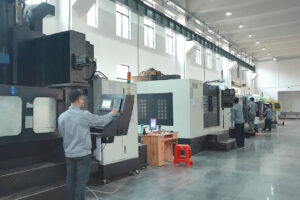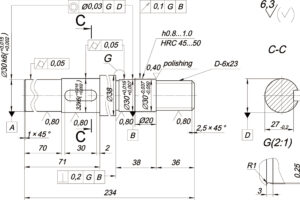What is steel?
Steel is a broad term for iron and carbon alloys. The carbon content (0.05%–2% by weight) and the addition of other elements determine the specific alloy of the steel and its material properties. Other alloying elements include manganese, silicon, phosphorus, sulfur, and oxygen. Carbon increases the hardness and strength of steel, while other parts can be added to improve corrosion resistance or machinability. Manganese is also often present in large amounts (at least 0.30% to 1.5%) to reduce the brittleness of the steel and increase its strength.
The strength and hardness of steel are one of its most sought-after properties. They make steel suitable for construction and transportation applications because it can be used for a long time under heavy and repeated loads. Some steel alloys, the stainless steel varieties, are resistant to corrosion, making them the best choice for parts operating in extreme environments.
However, this strength and hardness can also lead to longer machining times and increased wear on the cutting tool. Steel is a high-density material, making it too heavy for some applications. However, steel has a high strength-to-weight ratio, which is why it is one of the most commonly used metals in manufacturing.
What are the types of steel?
When carbon is added to iron, it becomes steel. The amount of carbon varies, resulting in very different properties. Carbon steel generally refers to steel other than stainless steel and is identified by a 4-digit grade of steel, more broadly known as low, medium, or high carbon steel.
- Mild steel: less than 0.30% carbon (by weight)
- Medium carbon steel: 0.3–0.5% carbon
- High carbon steel: 0.6% and above
The first digit on a four-digit scale indicates the principal alloying elements of steel. For example, 1xxx steel, such as 1018, will have carbon as the primary alloying element. 1018 steel contains 0.14–0.20% carbon, small amounts of phosphorus, sulfur, and manganese. This general-purpose alloy is used to machine spacers, shafts, gears, and pins.
Free-machining grades of carbon steel are re-vulcanized and re-phosphatized to break the chips into smaller pieces. This prevents long or large chips from tangling with the tool when cutting. Free-machining steels can reduce machining time but may reduce flexibility and impact resistance.
What are stainless steel and its applications?
Stainless steel contains the carbon but also about 11% chromium, which increases the material’s corrosion resistance. More chrome means minor rust! Adding nickel improves rust resistance and tensile strength. In addition, stainless steel has good heat resistance, making it suitable for applications in aerospace and other extreme environments.
According to the metal’s crystal structure, stainless steel can be divided into five types. The five types are austenite, ferrite, martensite, duplex, and precipitation hardening. Stainless steel grades are identified using three digits instead of four. The first number represents the crystal structure and main alloying elements.
For example, 300 series stainless sheets of steel are austenitic chromium-nickel alloys. 304 stainless steel is the most common grade because it has 18% chromium and 8% nickel. 303 stainless steel is a free-machining version of 304 stainless steel. Adding sulfur reduces its corrosion resistance, so Type 303 stainless steel is more prone to rusting than Type 304.
Stainless steel can be used in a wide range of industries. Type 316 stainless steel can be used in medical equipment, such as valve assemblies in machines and pipelines if machined properly. 316 stainless steel is also used to machine nuts and bolts, many of which are used in the aerospace and automotive industries. 303 stainless steel is used for gears, shafts, and other essential components in aircraft and automobiles.
What are tool steel and its applications?
Tool steels are used to make tools for various manufacturing processes, including die-casting, injection molding, stamping, and cutting. Many different tool steel alloys are tailored for other applications, but they are all known for their hardness. Each can withstand the wear and tear of multiple uses (steel molds used for injection molding can withstand a million or more injections of material) and are resistant to high temperatures.
A typical application of tool steel is injection molding molds, CNC machined from hardened steel to produce the highest quality parts. H13 steel is usually chosen because of its good thermal fatigue properties – its strength and hardness can withstand prolonged exposure to extreme temperatures.
The H13 mold is ideal for advanced injection molding materials with high melting temperatures, as it provides longer mold life than other steels – 500,000 to 1 million shots. At the same time, S136 is stainless steel, and the tool life is more than one million times. This material can be polished to the highest level for special applications where parts require high optical clarity.
Material comparison table for different types of steel:
17-4 (type 630) | stainless steel 304 | stainless steel 316 | mild steel 1018 | medium carbon steel 1045 | tool steel H13 | |
Density (g/cc) | 7.8 | 8.0 | 7.85 | 7.87 | 7.87 | 7.8 |
Tensile Strength (MPa) | 1379 | 215 | 240 | 370 | 485 | 1650 |
Tensile Strength (MPa) | 1448 | 505 | 550 | 440 | 515 | 1990 |
Hardness (Rockwell C) | 45 | N/A | N/A | N/A | N/A | 28-54 |
Hardness (Rockwell B) | N/A | 70 | 80 | 71 | 86 | N/A |
carbon content | 0.07% | 0.08% | 0.08% | 0.14%-0.2% | 0.42%-0.5% | 0.32%-0.4% |
manganese content | 1% | 2% | 2% | 0.6%-0.9% | 0.6%-0.9% | / |
phosphorus content | 0.04% | 0.045% | 0.045% | 0.04% | 0.04% | / |
sulfur content, | 0.03% | 0.03% | 0.03% | 0.05% | 0.05% | / |
chromium content | 15%-17.5% | 18%-20% | 16%-18% | / | / | 5.13%-5.25% |
nickel content, | 3%-5% | 8%-10.55 | 10%-14% | / | / | / |
copper content | 3%-5% | / | / | / | / | / |







